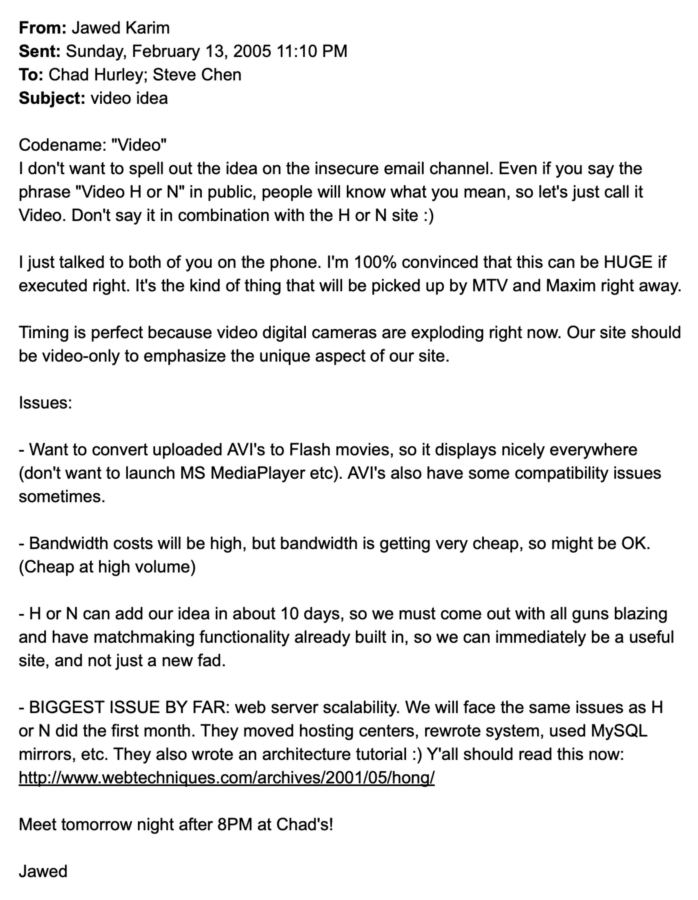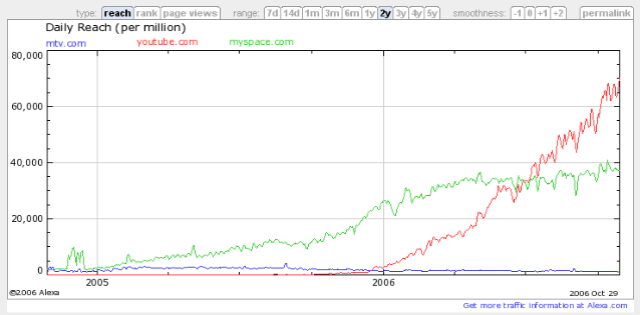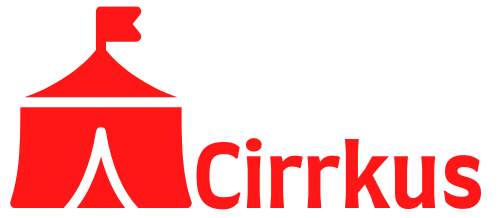On April 23, 2005, a grainy 18-second clip of a guy at the zoo launched a revolution. That was the very first video ever uploaded to YouTube. Fast forward 20 years, and chances are you’ve already visited the site today—maybe once, maybe twenty times. Whether you’re pulling up a how-to video, listening to music, arguing over a movie quote, or tumbling down a late-night rabbit hole of “recommended for you” chaos, YouTube has become a central part of daily life.
It’s hard to imagine now, but YouTube wasn’t always the unstoppable giant it is today. In its early days, critics thought it was a lawsuit magnet with no revenue model and an unsustainable burn rate. Even Google’s $1.65 billion acquisition in 2006 was widely mocked as reckless.
And yet, here we are. Two decades later, YouTube isn’t just a successful platform—it’s arguably the greatest business acquisition of all time. But to truly understand how it all began, we have to rewind to a single moment at the Super Bowl. A wardrobe malfunction. A pop culture shockwave. And a frustrated Stanford student who couldn’t find the clip online…
Janet Jackson’s Wardrobe Malfunction Changed The Internet
There are lots of stories about how the idea for YouTube came about. Was it the result of a simple brainstorming conversation between engineers at a party? Was it someone’s brilliant realization that it was hard to find clips of popular programs like The Daily Show, South Park, and Saturday Night Live, after they had aired? Or was it Janet Jackson’s exposed right breast? Believe it or not, it was Janet Jackson’s exposed right breast.
On February 1st, 2004, Janet Jackson and Justin Timberlake performed at the Super Bowl halftime show. At one point during their performance, Justin reached over and pulled off a piece of Janet’s costume. You can imagine the collective shock that hundreds of millions of viewers felt when they realized that removing that little piece of costume left Janet’s right nipple exposed to the world.
After this now-notorious nipple-slippage incident, a budding Stanford graduate student named Jawed Karim noted that it was damn near impossible to see the clip anywhere on the internet. Keep in mind that back in 2004, only a tiny percentage of the population had a DVR. And of those people who were lucky enough to own a DVR (and could rewind over and over and over and over), basically no one had the knowledge or equipment needed to download the footage off their TIVO onto a disk or flash drive that could then be transferred to a computer and ultimately a website.
Photo by Donald Miralle/Getty Images
YouTube.com
YouTube was the brainchild of Chad Hurley, Steve Chen, and Jawed Karim. The trio met while they worked for PayPal in the early 2000s. All three were smart, restless, and eager to strike gold in Silicon Valley. Hurley, a design graduate from Indiana University of Pennsylvania, brought the visual and user experience chops. Chen and Karim were coding prodigies who had studied computer science at the University of Illinois at Urbana-Champaign. After eBay acquired PayPal in 2002, the trio began casually brainstorming ideas for their own startup.
They were fascinated by the viral appeal of early internet culture, particularly a dating site called HotOrNot, where users could rate strangers’ photos. The simplicity and stickiness of that site got them thinking: what if there were a platform where anyone could upload videos just as easily?
Here’s an actual email (revealed thanks to Viacom’s $1 billion lawsuit against YouTube), sent by Jawed to Chad and Steve on February 13, 2005:

The trio purchased domain YouTube.com a day after Jawed sent that email – on February 14, 2005 – a romantic Valentine’s Day gesture to what would soon become one of the most transformative platforms on the internet. clicks.
After building a basic prototype, the team was ready to test their “minimum viable product.” On April 23, 2005, they uploaded the first-ever video to the site: an 18-second clip titled “Me at the Zoo.” It featured co-founder Jawed Karim standing in front of elephants at the San Diego Zoo, offering a casually awkward commentary on the animals’ trunks. Filmed by Karim’s friend Yakov Lapitsky, the video was unremarkable in content, but revolutionary in implication. It marked the official beginning of what would become the world’s go-to video platform. Here it is, in all its glory, still hosted on Jawed’s account. It is the only video on Jawed’s account:
After a few successful months of operation, the trio put together a proposal for Venture Capital firms. Using connections from their days at PayPal, they raised $11.5 million in funding from Sequoia Capital to get the business off the ground. The money was paid out between November 2005 and April 2006. They officially launched YouTube worldwide out of beta in November 2005.
Big-Boys.com
Chad, Steve, and Jawed were not the only web entrepreneurs who had the idea to put video on the internet. And in fact, they were a year or so late to the game.
Obviously, there was already lots of adult video websites, but even as early as 2004/2005, there were a bunch of online video sites that mostly focused on humorous content. One of those crucial early video sites was called Big-Boys.com.
[Disclosure: My first (and only) job out of college was at Big-Boys.com, hence my intimate knowledge of the history of internet video. I worked at Big-Boys/Break from July 2005 until February 2012, at which point I left to run CelebrityNetWorth full time.]
Big-Boys.com was founded by a web developer named Rob Nolte. The site was originally a resource for web developers. As fate would have it, Rob happened to be one of the only people in the world who possessed both a DVR and the ability to transfer content to his computer in February 2004, the day of the Janet Jackson nip slip.
After watching what happened live like the rest of the planet, the quick-thinking Nolte transferred the Janet Jackson clip from his DVR to his computer. He then proceeded to post the clip on Big-Boys.com. He figured a few random friends who did not have a DVR might want to check it out.
Twenty-four hours after the Super Bowl, if you googled “Janet Jackson Super Bowl video”, Rob’s big-boys.com link was the top result. Every day for the next month, Big-Boys.com was inundated with hundreds of thousands of visits.
Sensing an opportunity, Rob quickly scrapped his web developer website and started posting more videos. He also developed a way for users to upload videos. By the middle of 2004, he was posting 5-7 new videos to the homepage every day of the week. It was mostly prank videos, skateboard crashes, wild car crashes, and humorous homemade skits. And with that, arguably the first streaming video site in history was born.
Another early humor site, eBaumsworld, which had been around since 2001, saw Rob’s success with videos and quickly pivoted from posting images and soundboards to videos. A half dozen video and joke sites followed suit. This was all happening in March/April 2004, a year before the YouTube founders bought their domain. Big-Boys changed its name to Break.com in November 2005.
In mid-2005, the YouTube founders saw the success sites like Big-Boys and StupidVideos were having with funny videos. I remember posting a user-submitted video to the Big-Boys homepage and seeing it on the YouTube homepage a few hours later. At the time I thought YouTube users were stealing our videos and YouTube itself just didn’t care. As it turned out, the YouTube founders were the ones stealing our videos! As part of Viacom’s $1 billion lawsuit against YouTube, some fairly damaging emails between the founders came to light. For example:
In July 2005, Chad emailed Steve:
“We’re becoming another big-boys or StupidVideos!“
Steve Chen responded:
What’s the difference between big-boys/stupidvideos vs YouTube? If you look at the top videos on the site, it’s all this type of content.“
Later that month, Steve emailed Jawed and told him:
“Please stop putting stolen videos on the site. We’re going to have a tough time defending the fact that we’re not liable for the copyrighted material on the site because we didn’t put it up when one of the co-founders is blatantly stealing content from other sites and trying to get everyone to see it.“
How YouTube Took Over The World
While all this was going on in mid-2004 and throughout 2005, one of the biggest websites in the world was MySpace. And MySpace would soon be the key to YouTube becoming a global phenomenon.
At some point in mid-2005, Myspace gave its users the ability to customize their profile pages with externally embedded content and HTML markup codes. For better or worse (mostly worse), this innovation inspired millions of Myspace users to build customized profile pages decorated with all their favorite colors, animated GIFs, photos, and…most importantly: videos. If you wanted to embed a video on your Myspace page back in 2006, there was only one site on the internet that allowed that functionality: YouTube.
Want to force all your Myspace page visitors to listen to “Look At This Photograph” by Nickelback? Simply find the video on YouTube and grab the embed code. Want all your friends to see that viral video of the fat kid singing the “Numa Numa” song in his bedroom? YouTube had you covered.
YouTube’s early rise to dominance is directly correlated to the rise of Myspace. The graph below plots the traffic growth of Myspace (green line), YouTube (red line), and MTV.com (blue line), between 2005 and 2007. Notice how starting a little bit before 2006, Myspace and YouTube grew almost step for step? Then, right at the beginning of 2006, YouTube exploded in growth, eventually surpassing Myspace right around June 2006. So what caused YouTube to explode into the mainstream at the very beginning of 2006?

Lazy Sunday
Throughout most of 2005, YouTube was still a relatively small service used mainly to enhance Myspace profiles. Then, something magical happened right at the end of 2005.
On December 17, 2005, SNL aired a little video called “Lazy Sunday”. It was the very first SNL digital short, and it aired at the very end of the episode, which also happened to be the season finale. In other words, no one at SNL thought much would come of this silly little rap video. They were wrong.
The next day, the entire world was asking, “Did you see that SNL rap video??” By now, it had been almost two years since Janet Jackson’s nipple gate, and many more people had DVRs, but not many people were actually DVRing SNL. So, the day after the episode aired, everyone and their mother scrambled to find somewhere to watch it online (probably so they could post it to their Myspace pages).
Lazy Sunday wasn’t being replayed on NBC or anywhere on TV, so the only way to watch the clip was to Google things like “Lazy Sunday“, “SNL rap video“, “Chronicles of Narnia SNL“. The first result on Google for all of these queries was a link from YouTube. All of a sudden, the entire world was being introduced to, and very quickly falling in love with, the concept of internet video sharing. In the coming weeks, every mainstream newspaper and media outlet reported on the wonders of this new-fangled “YouTube” website and how internet videos were breathing life back into a dreary Saturday Night Live.
As Malcolm Gladwell would say, “Lazy Sunday” was YouTube’s tipping point. Within six months, YouTube was not only much bigger than Myspace, but it quickly became one of the largest websites in the world.
There was just one problem. Actually two big problems.
#1) With all that growth in video views, every month, YouTube was burning a small fortune thanks to its exponentially growing bandwidth expenses. Compounding the problem, YouTube had no revenues at all at that point, and no plan for earning revenues anytime soon. Throughout the first six months of 2006, YouTube was burning $1 million a month to cover bandwidth costs. And it was money they did not have. Their $11 million in VC money was long gone. At that point, they were limping along, possibly towards certain disaster.
#2) The vast majority of videos being uploaded to YouTube back then were copyrighted material. You could watch entire episodes of South Park, The Daily Show, Colbert, SNL, Family Guy, Conan, and thousands more. Even full-length pirated movies were uploaded! Many industry analysts (most vocally, Mark Cuban) were convinced that YouTube would inevitably be sued into oblivion by Turner, Viacom, NBC/Universal, Disney, or all of the above. And YouTube didn’t exactly have the money for lawyers.
Viacom did eventually sue YouTube for $1 billion. The courts sided with YouTube in 2013, citing the DCMA safe harbour provision.
Google Saves The Day
On October 9, 2006, Google Inc. purchased YouTube for $1.65 billion in stock—a move now widely considered one of the most brilliant acquisitions in tech history. At the time, Sequoia Capital earned approximately $500 million for its 30% stake, which it had acquired for just $11.5 million. YouTube co-founder Chad Hurley received roughly 730,000 shares of Google, valued at $395 million. Steve Chen received 635,000 shares worth $326 million, and Jawed Karim, who had left the company early to complete his graduate studies at Stanford, was awarded 137,000 shares, worth around $65 million.
Importantly, the entire deal was done in Google stock—no cash. At the time, Google shares were trading at a pre-split equivalent of $230 per share. Since then, the stock has split multiple times, including a major 20-for-1 stock split in July 2022. Adjusted for all splits, those original shares have multiplied dramatically.
As of April 2025, Alphabet Inc. (GOOGL) is trading at around $155 per share. That means Hurley’s original 730,000 shares would now equal 14.6 million shares, worth over $2.26 billion. Chen’s stake would be worth around $1.97 billion, and Karim’s around $425 million—if they had held on. After taxes, diversification, and personal ventures, we currently estimate Chad, Steve and Jawed’s net worths to be $700 million (Chad), $500 million (Steve), and $300 million (Jawed).
YouTube created entire new careers—vloggers, beauty gurus, gamers, finance influencers, and more. It made celebrities out of everyday people, changed how we consume music, and even influenced elections and revolutions.
Why YouTube Was The Greatest Business Acquisition Ever
In hindsight, Google’s $1.65 billion purchase of YouTube in 2006 looks less like a bold bet and more like legalized robbery. What started as a quirky video-sharing site with no revenue has become one of the most dominant media platforms in history.
Today, YouTube reaches more than 2.7 billion monthly users who watch over 1 billion hours of video every day. More than 500 hours of content are uploaded every minute. The platform has evolved far beyond cat videos, becoming a juggernaut in news, education, entertainment, live sports, and e-commerce.
In 2024, YouTube generated an estimated $47.7 billion in revenue, up from $3.5 billion in 2013. Analysts believe that if it were spun off today, YouTube could be worth $400–$500 billion as a standalone company. When Google closed the deal in 2006, its market cap jumped by $2 billion within days, effectively paying for the entire purchase on day one. All of the above combined is why many people, myself included, consider Google’s acquisition of YouTube the greatest business acquisition of all time.
Whether you’re watching a 4K space launch, learning how to change a tire, or rewatching ‘Lazy Sunday’ for the hundredth time, YouTube isn’t just a site. It’s part of how we live, laugh, learn, and remember.
Content shared from www.celebritynetworth.com.

